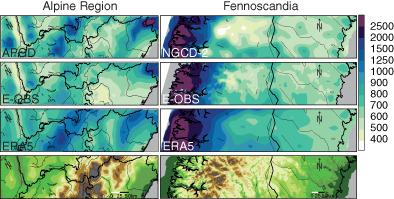当前位置:
X-MOL 学术
›
Int. J. Climatol.
›
论文详情
Our official English website, www.x-mol.net, welcomes your
feedback! (Note: you will need to create a separate account there.)
Evaluation of daily precipitation analyses in E-OBS (v19.0e) and ERA5 by comparison to regional high-resolution datasets in European regions
International Journal of Climatology ( IF 3.5 ) Pub Date : 2021-06-25 , DOI: 10.1002/joc.7269 Moritz Bandhauer 1 , Francesco Isotta 1 , Monika Lakatos 2 , Cristian Lussana 3 , Line Båserud 3 , Beatrix Izsák 2 , Olivér Szentes 2 , Ole Einar Tveito 3 , Christoph Frei 1
International Journal of Climatology ( IF 3.5 ) Pub Date : 2021-06-25 , DOI: 10.1002/joc.7269 Moritz Bandhauer 1 , Francesco Isotta 1 , Monika Lakatos 2 , Cristian Lussana 3 , Line Båserud 3 , Beatrix Izsák 2 , Olivér Szentes 2 , Ole Einar Tveito 3 , Christoph Frei 1
Affiliation

|
Gridded analyses of observed precipitation are an important data resource for environmental modelling, climate model evaluation and climate monitoring. In Europe, datasets that resolve the rich mesoscale variations widely exist for the national territories, but similar datasets covering the entire continent are more recent. Here, we evaluate daily precipitation in two newly available pan-European datasets: E-OBS (v19.0e), a statistical analysis from rain-gauge data, and ERA5, the new global reanalysis from ECMWF. Special interest is on how the refinements of grid spacing, the methodological upgrades and the quantification of uncertainty (ensemble), bear on capabilities at the mesoscale. The evaluation is conducted in three subregions, the Alps, the Carpathians and Fennoscandia, and involves as reference high-quality regional datasets derived from dense rain-gauge data. The study suggests that E-OBS and ERA5 agree qualitatively well with the reference datasets. Major mesoscale patterns in the climatology (mean, wet-day frequency, 95% quantile) are reproduced. The improvement over earlier versions of the datasets is evident. ERA5 was found to overestimate mean precipitation in all regions, related to too many wet days. The accuracy of E-OBS was found to depend on station density, with spatial and temporal variations clearly less accurate in data sparse regions. In comparison, E-OBS turned out to be superior to ERA5 in regions with dense data, but the two datasets are on a par in regions with sparse data, and partly ERA5 has advantages. For both datasets we find that the spatial resolution is coarser than the grid spacing, with overly smooth fields and an underestimation of high quantiles. Also, both datasets were found to be clearly overconfident in their uncertainty characterization (too small ensemble spread). Overall, the two datasets advance the characterization of precipitation on a pan-European scale, but users are advised to take residual limitations into account in applications.
中文翻译:

通过与欧洲地区的区域高分辨率数据集进行比较,评估 E-OBS (v19.0e) 和 ERA5 中的每日降水分析
观测降水的网格化分析是环境建模、气候模式评价和气候监测的重要数据资源。在欧洲,解决丰富的中尺度变化的数据集广泛存在于国家领土上,但覆盖整个大陆的类似数据集是较新的。在这里,我们评估了两个新可用的泛欧数据集的每日降水量:E-OBS (v19.0e),雨量计数据的统计分析,以及 ERA5,ECMWF 的新全球再分析。特别感兴趣的是网格间距的细化、方法升级和不确定性(集合)的量化如何影响中尺度能力。评估在阿尔卑斯山、喀尔巴阡山脉和芬诺斯坎迪亚三个次区域进行,并涉及作为参考的高质量区域数据集,这些数据集源自密集的雨量计数据。该研究表明,E-OBS 和 ERA5 在质量上与参考数据集吻合得很好。再现了气候学中的主要中尺度模式(平均、潮湿日频率、95% 分位数)。对早期版本的数据集的改进是显而易见的。发现 ERA5 高估了所有地区的平均降水量,这与过多的雨天有关。发现 E-OBS 的准确性取决于站点密度,在数据稀疏区域,空间和时间变化的准确性明显较低。相比之下,E-OBS 在数据密集的区域优于 ERA5,但在数据稀疏的区域,这两个数据集不相上下,部分 ERA5 具有优势。对于这两个数据集,我们发现空间分辨率比网格间距更粗糙,具有过于平滑的字段和对高分位数的低估。此外,发现这两个数据集在其不确定性表征上明显过度自信(集成传播太小)。总体而言,这两个数据集在泛欧洲范围内推进了降水的表征,但建议用户在应用中考虑剩余限制。
更新日期:2021-06-25
中文翻译:

通过与欧洲地区的区域高分辨率数据集进行比较,评估 E-OBS (v19.0e) 和 ERA5 中的每日降水分析
观测降水的网格化分析是环境建模、气候模式评价和气候监测的重要数据资源。在欧洲,解决丰富的中尺度变化的数据集广泛存在于国家领土上,但覆盖整个大陆的类似数据集是较新的。在这里,我们评估了两个新可用的泛欧数据集的每日降水量:E-OBS (v19.0e),雨量计数据的统计分析,以及 ERA5,ECMWF 的新全球再分析。特别感兴趣的是网格间距的细化、方法升级和不确定性(集合)的量化如何影响中尺度能力。评估在阿尔卑斯山、喀尔巴阡山脉和芬诺斯坎迪亚三个次区域进行,并涉及作为参考的高质量区域数据集,这些数据集源自密集的雨量计数据。该研究表明,E-OBS 和 ERA5 在质量上与参考数据集吻合得很好。再现了气候学中的主要中尺度模式(平均、潮湿日频率、95% 分位数)。对早期版本的数据集的改进是显而易见的。发现 ERA5 高估了所有地区的平均降水量,这与过多的雨天有关。发现 E-OBS 的准确性取决于站点密度,在数据稀疏区域,空间和时间变化的准确性明显较低。相比之下,E-OBS 在数据密集的区域优于 ERA5,但在数据稀疏的区域,这两个数据集不相上下,部分 ERA5 具有优势。对于这两个数据集,我们发现空间分辨率比网格间距更粗糙,具有过于平滑的字段和对高分位数的低估。此外,发现这两个数据集在其不确定性表征上明显过度自信(集成传播太小)。总体而言,这两个数据集在泛欧洲范围内推进了降水的表征,但建议用户在应用中考虑剩余限制。









































 京公网安备 11010802027423号
京公网安备 11010802027423号